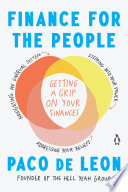

The book emphasizes the importance of understanding the fundamentals of personal finance, which includes budgeting, saving, and managing debt. It introduces readers to the concept of financial literacy, which is crucial for making informed decisions about money. The author explains how many people lack basic financial knowledge, leading to poor financial choices that can have long-term repercussions. The book provides practical advice on how to create a budget, track expenses, and set financial goals. By mastering these basics, individuals can gain control over their finances and work towards financial independence.
Continue readingOne of the central themes of the book is the significance of saving money and having an emergency fund. The author discusses the psychological and practical benefits of saving, which include reduced stress and increased financial security. The book recommends that readers aim to save a certain percentage of their income each month and outlines strategies for building an emergency fund that can cover three to six months' worth of expenses. This idea is particularly relevant in today's uncertain economic climate, where job security is not guaranteed, and unexpected expenses can arise.
Continue readingThe book delves into the world of investing, explaining the different types of investment vehicles available, such as stocks, bonds, mutual funds, and real estate. It demystifies the investment process, making it accessible to readers who may feel intimidated by the stock market. The author emphasizes the importance of starting to invest early, taking advantage of compound interest, and diversifying one's investment portfolio. The book also addresses common misconceptions about investing, such as the idea that it requires a lot of money to start. By encouraging readers to view investing as a long-term strategy, the book empowers them to build wealth over time.
Continue readingA significant portion of the book is dedicated to understanding credit and how to manage debt effectively. The author explains how credit scores work, the impact of debt on financial health, and strategies for paying off debt. The book provides practical tips for improving credit scores, such as making timely payments and reducing credit utilization. This idea is particularly important for young adults and those new to credit, as it helps them avoid common pitfalls that can lead to financial distress. The author also discusses the difference between good debt and bad debt, guiding readers on how to leverage debt responsibly.
Continue readingThe book discusses the various financial institutions that individuals interact with, such as banks, credit unions, and investment firms. It explains the services these institutions offer and how to choose the right ones for personal financial needs. The author highlights the importance of being an informed consumer, understanding fees, interest rates, and the terms of financial products. This knowledge empowers readers to make better financial decisions and avoid predatory practices. The book also touches on the role of technology in finance, such as online banking and fintech apps, which can enhance financial management.
Continue readingIn light of economic fluctuations and uncertainties, the book provides guidance on how to navigate financial challenges. The author discusses the importance of adaptability and resilience in personal finance, encouraging readers to be proactive in their financial planning. This includes reassessing financial goals, adjusting budgets, and being prepared for potential job loss or market downturns. The book emphasizes the need for continuous learning and staying informed about economic trends, which can impact individual finances. By fostering a mindset of adaptability, readers can better weather financial storms.
Continue readingFinally, the book advocates for the idea of building a financially empowered community. The author stresses the importance of sharing financial knowledge and resources with others, creating a supportive environment for financial growth. This concept extends beyond individual finances to encompass collective financial well-being. The book encourages readers to engage in discussions about money, share experiences, and support one another in achieving financial goals. By fostering a culture of financial literacy and empowerment, communities can uplift their members and create a more equitable financial landscape.
Continue reading